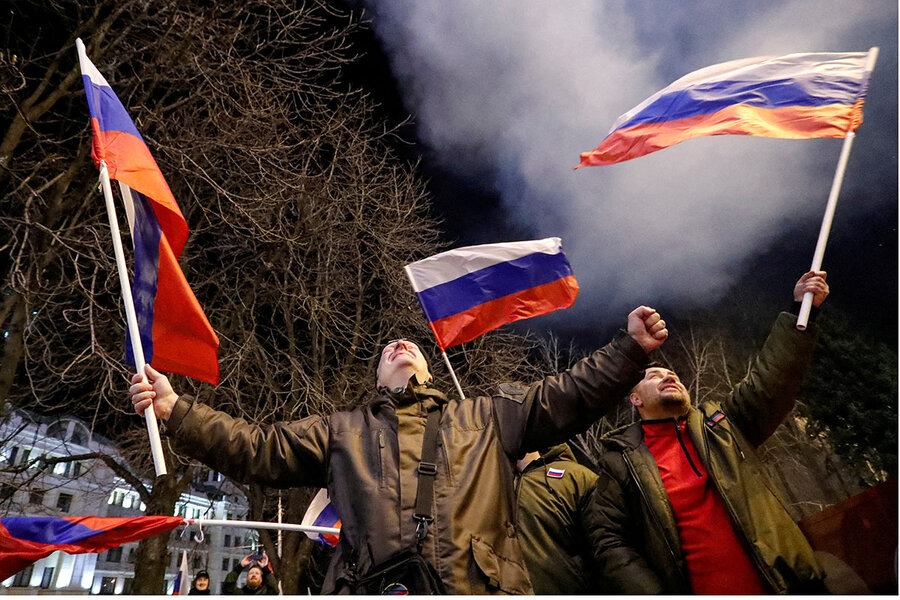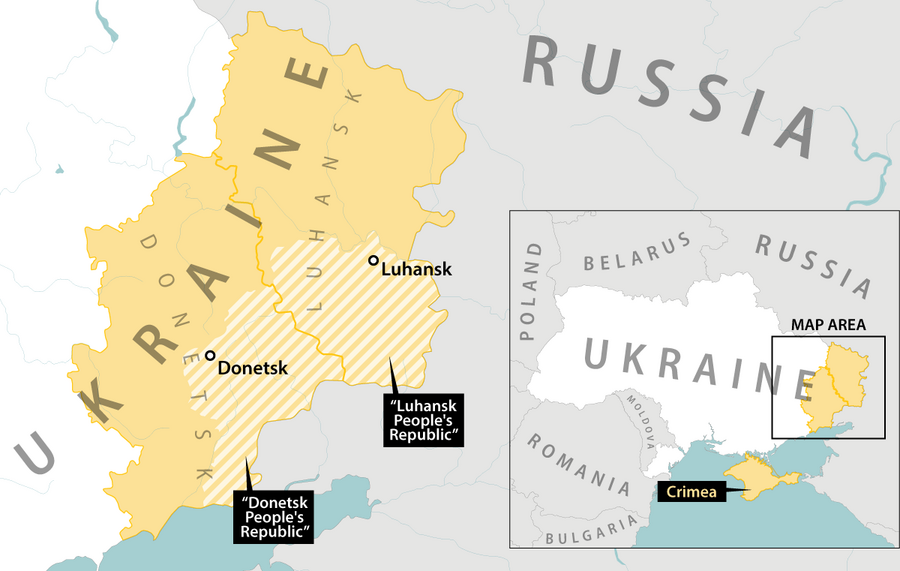Diplomacy over? Russian troops enter Ukraine’s rebel regions.
Loading...
| Moscow
What had been an armed Russian buildup along its border with Ukraine to compel the West to formally relinquish all plans to expand NATO now looks set to turn into a concerted, if localized, military campaign to destroy Ukrainian statehood.
Russian President Vladimir Putin extended Moscow’s formal recognition to the two breakaway Ukrainian statelets of Donetsk and Luhansk, formalizing the de facto autonomy and Russian military backing that has been a reality for the past eight years.
Why We Wrote This
By recognizing the Donbass breakaway statelets, Russian President Vladimir Putin shut the door on several diplomatic outcomes in the Ukraine crisis. War, albeit a limited one, may be his intended next step.
Russian mechanized troops are now deploying to the regions, where they will replace the local militias who have been facing off with Ukrainian forces since 2014. Ominously, the Kremlin has indicated that it accepts the two republics’ territorial claims over the entire Donbass, two-thirds of which is still held by Ukraine.
“I think the kind of massive Russian invasion that the U.S. media has been predicting remains very unlikely,” says Volodymyr Ishchenko, a Ukrainian sociologist. “The course Putin has decided upon is much different – safer for Russia but leading to the gradual destabilization of Ukraine. There will be questions about the borders of the two republics, which may lead to sharp clashes between Russian and Ukrainian forces as before. But it will be limited war.”
With a long speech and a flourish of his pen, Russian President Vladimir Putin abruptly transformed the months-long struggle over Ukraine from a simmering information war into one that is likely to turn kinetic in coming days.
What had been a threatening armed buildup along the border that aimed to compel the West to formally relinquish all plans to expand NATO to the east now looks set to turn into a concerted, if localized, military campaign. Its goal: destroy Ukraine’s three-decade-old independent statehood – at least within the borders it inherited from the former Soviet Union in 1991.
On the surface, little has actually changed.
Why We Wrote This
By recognizing the Donbass breakaway statelets, Russian President Vladimir Putin shut the door on several diplomatic outcomes in the Ukraine crisis. War, albeit a limited one, may be his intended next step.
After listing Russia’s perceived grievances going back almost a century, Mr. Putin extended Moscow’s formal recognition to the two breakaway Ukrainian statelets of Donetsk and Luhansk, formalizing the de facto autonomy and Russian military backing that has been a reality for the past eight years.
Moscow did the same thing to forestall Georgia’s westward drift after a brief 2008 war, by recognizing the independence of the two separatist republics of Abkhazia and South Ossetia, and making them military protectorates. (Russian analysts point out that NATO also did something similar, by granting still-disputed independence to Serbia’s former province of Kosovo following an 11-week war in 1999.)
But that is where similarities end. Russian mechanized troops are now deploying to Donetsk and Luhansk, where they will replace the local militias who have been facing off with Ukrainian forces since 2014. Ominously, the Kremlin has indicated that it accepts the two republics’ territorial claims over the entire Donbass, two-thirds of which is still held by Ukraine.
According to Vladimir Evseev, a military expert with the Kremlin-funded Institute of the Commonwealth of Independent States in Moscow, 150,000 Ukrainian troops – over half of Ukraine’s army – are presently concentrated in the Donbass. Russian and Ukrainian forces fought pitched battles on this terrain twice before, in 2014 and 2015, and another confrontation appears imminent.
“I think the kind of massive Russian invasion that the U.S. media has been predicting remains very unlikely,” says Volodymyr Ishchenko, a Ukrainian sociologist and expert at the Institute of East European Studies, Freie Universität Berlin. “The course Putin has decided upon is much different – safer for Russia but leading to the gradual destabilization of Ukraine. There will be questions about the borders of the two republics, which may lead to sharp clashes between Russian and Ukrainian forces as before. But it will be limited war.”
One immediate, and crucial, change is that the Minsk II agreement, a roadmap to peace in eastern Ukraine signed in 2015 by Russia, Ukraine, Germany, and France, is now a dead letter. As recently as last weekend it seemed possible, amid a flurry of diplomacy by French and German leaders, that Ukrainian President Volodymyr Zelenskyy might be pressed to implement the accord, which would have led to the reintegration of Donetsk and Luhansk into a newly federalized Ukraine. That would have been angrily opposed by Ukrainian nationalists who saw Minsk II as a formula to prevent the nationalist project of integrating into the West at Russia’s expense.
“Ukrainian nationalists may actually be happy to see that Minsk II can never be revived. Their opposition is the main reason Zelenskyy couldn’t implement it even if he wanted to,” says Dr. Ishchenko. “Zelenskyy is now in trouble, his popularity is plunging, and polls show that the majority of Ukrainians don’t see him as a suitable commander in chief. There is a real danger of nationalist violence as this crisis develops. That would be very good for Putin.”
“Quite dangerous when politicians turn into historians”
In a lengthy televised speech Monday evening, Mr. Putin went far beyond laying out a practical rationale for recognizing the rebel republics, and clearly called into question Ukraine’s sovereign existence.
Large swaths of Ukraine, including the Donbass, Crimea, and other areas in the country’s east, were part of Russia for 300 years, and were only incorporated into the Soviet republic of Ukraine by what Mr. Putin bitterly described as the “anti-Russian” policies of Vladimir Lenin and the Bolsheviks. While it’s true that majorities in those regions are Russian-speaking and sympathy for the Donbass separatists is common, experts note that Mr. Putin is explicitly challenging the accepted global order, whose basic building block is the sovereign state and its territorial integrity.
“The way Putin sounded, it seems like the long-term goal is to get rid of Ukraine as a state,” says Fyodor Lukyanov, chairman of the Council for Foreign and Defense Policy, a high-level think tank which often advises the Kremlin. “It can be quite dangerous when politicians turn into historians, and use that to justify concrete acts. Any narrative is a construct, and not a very good guide to policy.”
Mr. Lukyanov says that Western sanctions are unlikely to deter Russia, which has been preparing for this moment since the barrage of sanctions began when Moscow annexed Crimea in 2014.
Any really tough sanctions, such as cutting Russia out of the global banking system or canceling the Nord Stream 2 gas pipeline, would have devastating effects on Russia but also deliver damaging blowback to the global economy, particularly for Europeans, who get 40% of their natural gas and 25% of their oil from Russia. German Chancellor Olaf Scholz announced Tuesday that certification of Nord Stream 2 would be suspended indefinitely, following Mr. Putin’s decision to recognize the rebel republics.
Diplomacy may not yet be finished. Russian Foreign Minister Sergey Lavrov is slated to meet U.S. Secretary of State Anthony Blinken in Geneva on Thursday. That could offer a shred of hope.
“If things do not escalate further, it needn’t be the end of diplomacy,” says Mr. Lukyanov.
It may be too soon to gauge the Russian public’s response to the gathering war clouds. A survey done last weekend by the state-funded VTsIOM agency found that 78% of Russians supported the government’s decision to take in tens of thousands of refugees from Donetsk and Luhansk who were fleeing alleged attacks by Ukrainian forces. Just 13% opposed the plan.
“Average Russians think that Putin showed strength in this situation, due to the NATO factor and the fact that the people in those separatist regions are [seen as] Russians,” says Olga Kryshtanovskaya, a leading Russian sociologist, whose husband is Ukrainian. “Putin’s speech was contradictory. But people do believe that NATO expansion is a problem. People aren’t really analyzing things clearly, or assessing the consequences that are bound to be coming.”











